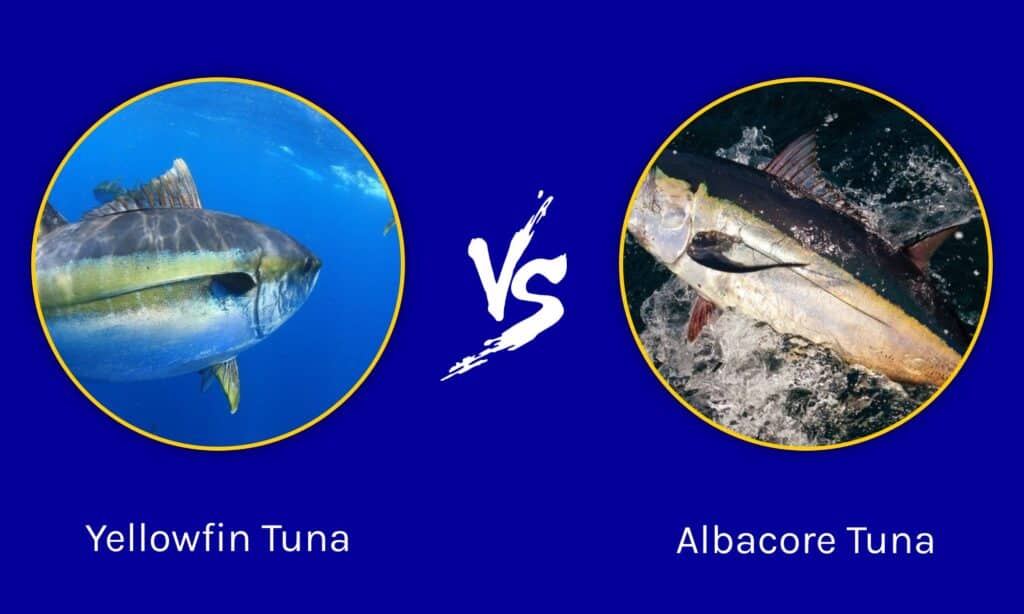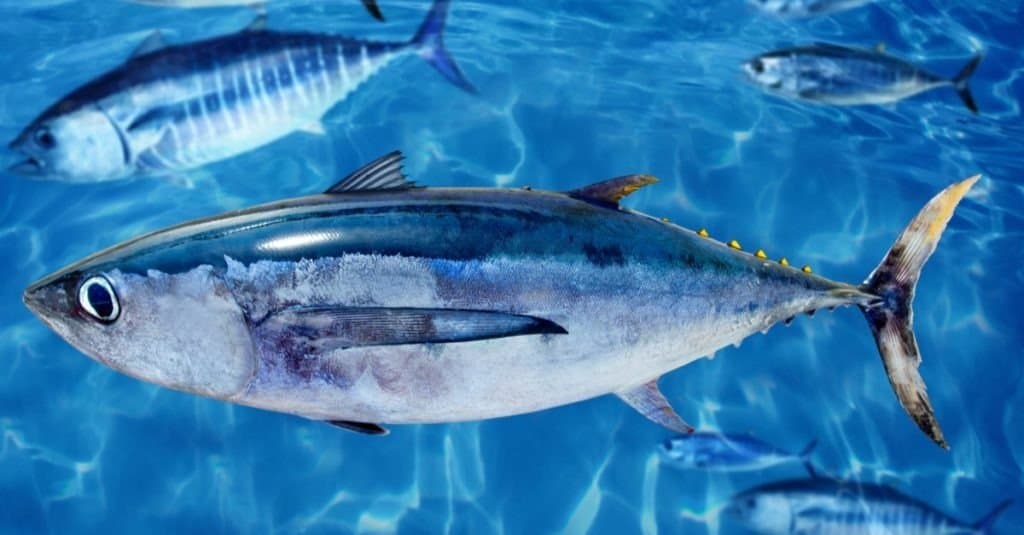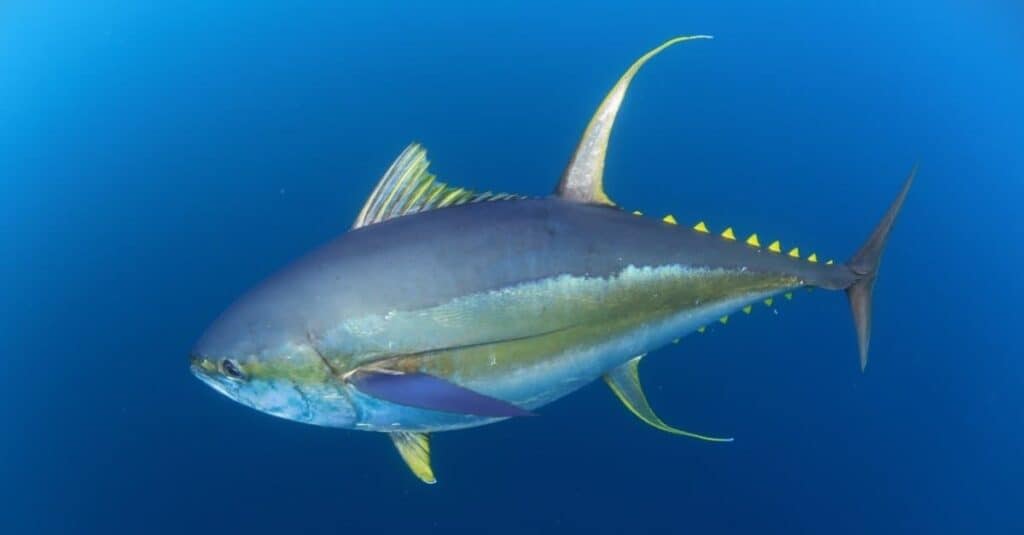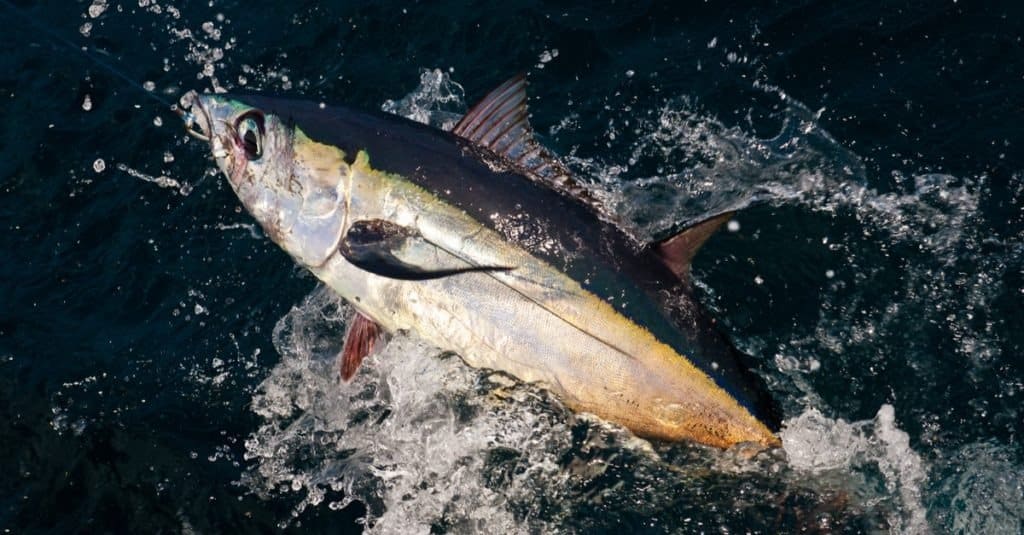The yellowfin tuna and albacore are both species of tuna found in tropical and temperate oceans across the globe. They are listed in the IUCN Red List as of Least Concern because of their abundance. As good as that sounds, their huge population is precisely where the “trouble” starts.
Yellowfin tuna and albacore are similar in appearance, especially if they are the same size. Both species often travel in schools with similarly sized companions, which is why they are often confused for one another. So, how do you tell yellowfin tuna vs albacore apart, then? That’s exactly what you’re going to learn from this article today.
Comparing Yellowfin Tuna vs Albacore

| Key Differences | Yellowfin Tuna | Albacore |
|---|---|---|
| Size | Weight: up to 450 pounds Length: up to 7 feet (2 m) | Weight: up to 80 pounds Length: 4 feet (1.2 m) |
| Body shape | Torpedo-shaped with a round body and lots of vertical lines | Has remarkably long pectoral fins, large eyes, and an elongate, fusiform body |
| Color | Yellow, blue, silver | Grey, blue, silver |
| Distribution and habitat | Typically found in deep offshore waters | Prefer areas where warm and cool water mix |
| Lifespan | 7 to 8 years | 10 to 12 years |
5 Key Differences Between Yellowfin Tuna and Albacore
The key differences between yellowfin tuna and albacore are their size, body shape, color, and lifespan. Although they are so much alike, the yellowfin tuna has distinct long yellow-colored secondary fins, while the albacore has long pectoral fins that stretch across the body. The yellowfin tuna is among the biggest tuna species.
Let’s examine all these differences in more detail to help you discern between the two species.
Yellowfin Tuna vs Albacore: Size

The albacore is smaller than the yellowfin tuna and is also one of the smallest of the bluefin tuna.
©lunamarina/Shutterstock.com
Although they are slightly smaller than the Atlantic and Pacific bluefin tunas, yellowfin tunas are among the largest tuna species. An adult yellowfin tuna can reach up to 450 pounds in total weight and about 2m (7 feet) in length. The largest recorded species of yellowfin tuna stands at 427 lb (193.68 kg); it was caught in 2012 off Cabo San Lucas, Mexico.
The albacore is smaller than the yellowfin tuna and is also one of the smallest of the bluefin tuna. It’s only a bit larger than the skipjack. Adult albacore may weigh up to 80 pounds and stands between 0.9 and 1.2 m (2 and 4 feet).
Yellowfin Tuna vs Albacore: Body Shape
The yellowfin tuna is a large fish that looks like a torpedo. It has a round body that is silvery white on the bottom and metallic blue-green on the top, with many light vertical lines. Unlike most bluefin tunas, yellowfin tunas have longer pectoral fins but not as long as those of the albacore. The second dorsal and anal fins reach almost as far back as the tail and give the appearance of scimitars and sickles.
On the contrary, the albacore has a smooth, fusiform body, with remarkably long pectoral fins, big eyes, a conical snout, and a large mouth. The pectoral fins begin just in front of the first dorsal fin and reach all the way to the second dorsal finlet, which is typically further forward than the anal fin.
Yellowfin Tuna vs Albacore: Color

The yellowfin tuna comes in a wide range of colors.
©Al McGlashan/Shutterstock.com
The yellowfin tuna comes in a wide range of colors. Its body is dark metallic blue, changing to silver on the belly. Other yellowfin tuna species range in color from deep red to pink and brown to yellow. The albacore is deep blue dorsally, with shades of silvery white ventrally covered by small scales. Albacore is the only tuna species called “white tuna.”
Yellowfin Tuna vs Albacore: Distribution and Habitat

Yellowfin tunas are abundant throughout the Pacific, Atlantic, and Indian Oceans.
©Al McGlashan/Shutterstock.com
Of all the tuna species, yellowfin and albacore are among the most widespread. Both tend to swim in tropical and temperate waters across the globe, but, of the two, yellowfin tunas prefer deep offshore water above the thermocline in the top 330 feet of the sea and can still dive to depths of at least 3800 feet.
Yellowfin tunas are abundant throughout the Pacific, Atlantic, and Indian Oceans, especially from San Diego to Puerto Vallarta and Nova Scotia down to North Carolina. They frequently visit places like the Canaries, Azores, Catalina Island, Hawaii, Bermuda, Bahamas, and as far east as New Zealand and Australia.
The albacore tuna prefer areas where warm and cool water mix. In the United States, the albacore tunas can be found along the west coast, from California and Oregon up to Washington. You may also find them around the Bay of Biscay in Europe.
Yellowfin Tuna vs Albacore: Reproduction and Lifespan

Albacore tunas release eggs and sperm simultaneously after mating for external fertilization.
©David Vogt/Shutterstock.com
Yellowfin tuna spawn throughout the year (peak spawning season occurs in summer). Females release millions of eggs into the water surface for external fertilization. The few that survive into adulthood reach sexual maturity in two to three years and live for approximately seven to eight years.
Like the yellowfin tuna, fertilization is considered external in albacore tunas. After mating, albacore tunas release eggs and sperm simultaneously for external fertilization. The few albacore hatchlings that survive this initial stage will mature in five to six years and live up to 12 years.
The photo featured at the top of this post is © lunamarina/Shutterstock.com
Thank you for reading! Have some feedback for us? Contact the AZ Animals editorial team.






